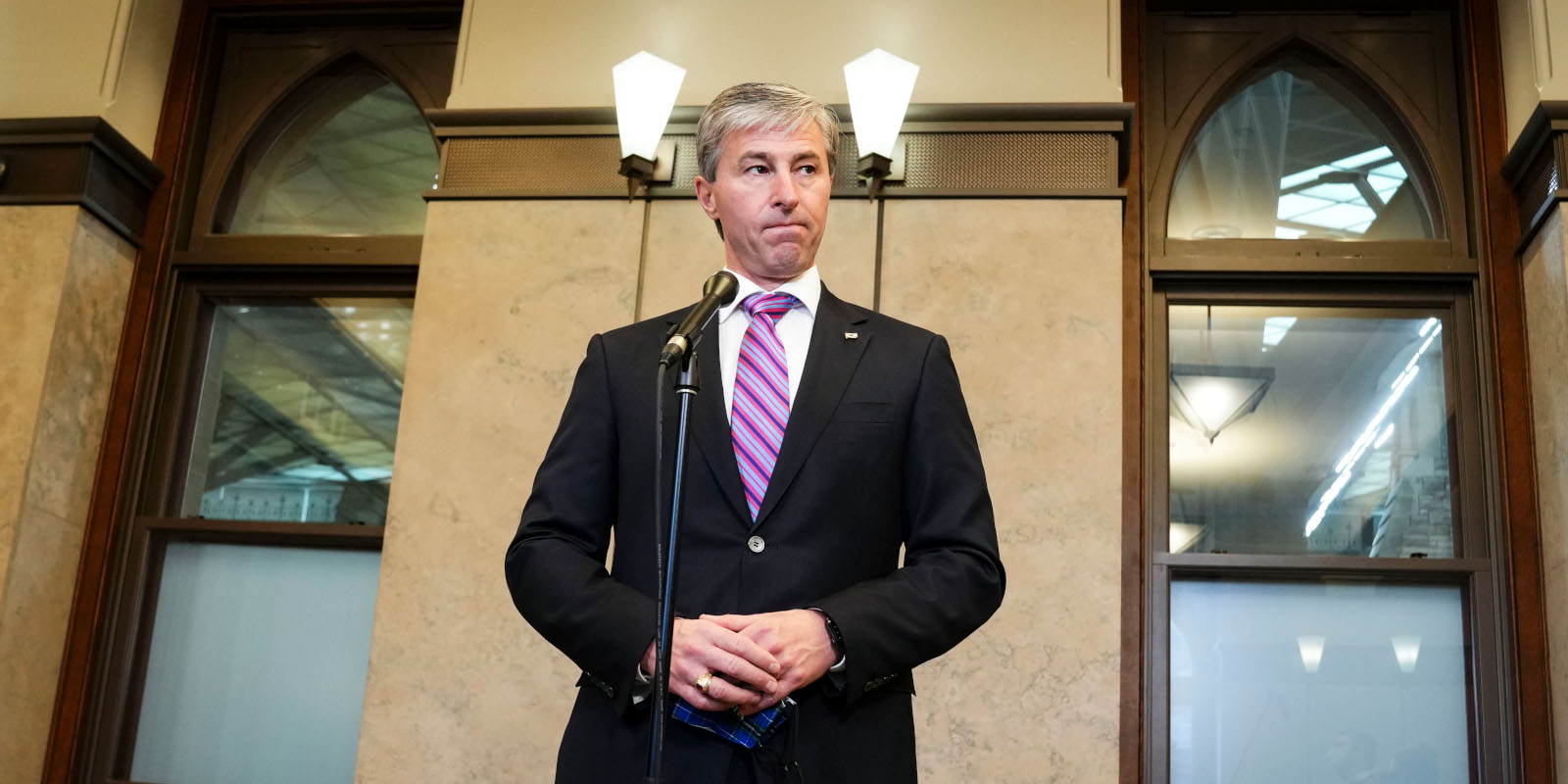Tim Houston’s Progressive Conservative government in Nova Scotia has opened the fiscal taps and doesn’t plan to close them until 2026, even if it means borrowing hundreds of millions of dollars.
The deficit, originally projected at $506 million for 2022-2023 alone, is targeted at fixing the province’s flagging health-care system.
The spending program departs from conventional conservative ideas about governments living within their means and some critics say it is irresponsible. But Houston and his backers say there is no other choice but to spend those millions to fix health care.
On the charge Houston’s government is not legislating conservative policies, they strongly disagree as well.
“The McNeil government didn’t spend. I think people were ready for a government to willingly spend on priorities like health care, seniors, and long-term care,” says Houston in an exclusive interview with The Hub.
The question for pundits and scholars is whether this is a new kind of big-spending conservative or simply a pragmatic politician doing what it takes to get elected.
“There’s Western conservatism, Prairie conservatism. It’s going to look quite different from conservatism in Ontario, conservatism in Quebec and then conservatism in Atlantic Canada,” says Hub contributor and political theorist Ben Woodfinden. “The very nature of us being a regional country means the federal conservatism at the federal level is going to have to reflect that kind of diversity.”
Regardless of just how his government is labelled, Houston is one of Canada’s most popular premiers. Some commentators have suggested the federal Conservative Party should take cues from Houston, but Woodfinden disagrees. He acknowledges Houston’s government may offer some lessons but says there is no nationwide model for conservatism in Canada.
Last summer, Houston’s PCs defied polling and swept to a majority government in the 2021 provincial election, ending eight years of Liberal governance in Nova Scotia. Houston won that election by promising a break from the spending policies of the previous government. In other words, when it came to government spending, he essentially ran to the left of his Liberal opponent.
From 2013 to 2021, Liberal Premier Stephen McNeil oversaw one of the most austere governments in the province’s recent memory. He balanced five-consecutive budgets, cut taxes for businesses and the middle class, battled labour unions, and oversaw an improved credit rating for Nova Scotia.
Nova Scotia’s economic and fiscal situation stabilized under McNeil, but critics charged health care got worse, despite the former premier’s promising every Nova Scotian would have a family doctor when first elected in 2013. By 2015, Nova Scotia’s health-care system was ranked among the worst in all of Canada.
To balance the budgets, McNeil cut millions in health-care spending. Among the most infamous were $3.1 million reductions in funding to long-term care facilities, leading to protests outside his constituency office.
By 2018, surveys showed McNeil was the least popular premier in Canada, although his Liberals mostly surpassed the opposition parties in polling. Houston, who became PC leader that same year, has acknowledged McNeil’s greatest achievement was balancing the budget but criticized him for doing so “on the backs of frontline workers” like health-care professionals.
While the health-care system in Halifax has its challenges, the situation in rural areas is more dire, with intermittent facility closures and chronic shortages of medical professionals.
In Middleton, within McNeil’s own riding in the Annapolis Valley, almost one-third of the population had no family doctor in 2021.
When McNeil left politics that year, his personal approval ratings had soared due to his quotable handling of the pandemic, but the province’s waitlist for a family doctor was 56,000.
“He (McNeil) left the health-care system in Nova Scotia in shambles,” says David Tarrant, Vice-President of National Strategic Communications Enterprise Canada, and Atlantic office head.
Iain Rankin replaced McNeil as premier and Liberal leader in February 2021 and soon called a summer election. When the writ dropped, the Rankin-led Liberals were sailing on double-digit polling leads that peaked at 12 points over the PCs. Health care, however, remained the top issue for Nova Scotians.
Tarrant was a senior strategist for Houston during the 2021 provincial election. While discussing a plan to win the contest, Tarrant says many people around Houston were adamant the PCs would lose if they ran on health care. The party last governed Nova Scotia in 2009.
Twelve years later, with a health-care situation described as a crisis, Houston questioned why the PCs could not centre their campaign around the issue. Houston settled on a deficit spending pitch, to the tune of $553 million for the first year and six years of deficits, intended mostly to fix Nova Scotia’s health-care system.
“People need to see better health care. Being a conservative should not mean you want to sacrifice health-care spending,” says Tarrant. “Tim, in a way that I think few others did, recognized that.”
Despite his bold pledge, the PCs never overcame their polling lead throughout the election period, although it narrowed to a near-tie in the final days.
On election day, Houston’s PCs won a surprise 31-seat majority in the 55-seat House of Assembly. Nearly every rural riding that McNeil’s Liberals won in the previous election flipped to the PCs. Houston was sworn in as premier on August 31.
Just over a year later, Nova Scotia’s government under Houston has thoroughly broken with the fiscally conservative McNeil era.
The PC government did not table its first budget until March 2022. It passed, costing $13.2 billion, $5.7 billion of which was directed towards health care, along with the promised, albeit slightly reduced, $506 million deficit.
Prior to passing the budget, the new government had already begun work on its plan to improve health care, including announcing job offers for all nurses graduating in Nova Scotia and expanding virtual care to the now 88,000 people on the family doctor waiting list. The government also invested $57 million to draw and retain healthcare professionals.
Among the Houston government’s ultimate goals for health care are adding 2,500 long-term care beds and incentives for new health-care professionals, like a pension plan for doctors.
“I’m comfortable running deficits in the short-term in order to make investments needed in health care because I know failing to do so would result in greatest costs in the coming years,” says Houston. “We need to take a long-term look at the system, and the reality is investments were needed to repair the system.”
The government’s deficit spending has been criticized by the Canadian Taxpayers Federation (CTF). Jay Goldberg is the CTF’s interim Atlantic director. The deficit did not wholly surprise him, given Houston’s election platform, but Nova Scotians should expect fiscal propriety from the right-of-centre PCs, he says.
Goldberg says rampant inflation and interest rate hikes make it imperative for Houston’s government to tamp down spending
“If the government wants to increase spending in some areas, such as health care, they need to identify other areas where they can find savings so as not to balloon the deficit,” says Goldberg.
Tarrant says that as a chartered accountant before entering politics, one of Houston’s biggest assets is that everyone understands deficit spending is not his preferred approach.
In a May speech to the Halifax Chamber of Commerce, Houston promoted the need to invest in health care, while acknowledging his own apprehension about ballooning deficits.
“As an accountant, as a PC, a $500 million deficit is turning my hair even a little bit grayer,” said Houston to the Chamber. “This is a time when we have to invest in people. This is the right time.”
Nova Scotia’s population broke the 1 million mark for the first time in 2021, and rural Nova Scotia is growing faster than rural regions in other provinces. One town, Lunenburg, grew by six percent from 2016 to 2021.
Susan Corkum-Greek was the general manager of the Lunenburg Academy of Music when Houston’s leadership of the PCs got her motivated to get involved prior to the 2021 provincial election. She now serves as the MLA for Lunenburg and is the minister of economic development in his cabinet.
As of 2021, 43 percent of Nova Scotians reside in rural areas, compared to 18 percent across Canada as a whole. Corkum-Greek says rural and urban development are not separate, and that the former’s interests, like improved rural health care, are well-represented by the government.
“(I) do think that in running the slate of candidates we did, we were able to speak to that rural representation, rural services, rural economics,” says Corkum-Greek. “Rural economic development is economic development, and I think when we parse it out, we actually do a disservice.”
Corkum-Greek says better health care is needed to keep up with Nova Scotia’s demographic and economic growth.
“In its absence, it becomes perhaps a reason to be cautious about making a move to Nova Scotia,” says Corkum-Greek. “With so much opportunity here, we can’t afford for that to happen.”
Houston has expressed the need to address Nova Scotia’s labour shortages as the economy grows back post-pandemic, and to ensure sufficient medical infrastructure to sustain it.
“We’re making unprecedented investments in health care to help transform it into a modern health-care system that meets the needs of Nova Scotians now and into the future,” says Houston. “A healthier population is one that supports a strong economy.”
In opposition, the Liberals have kept up a steady stream of criticism of the PCs. The rollout of improved health care and the government’s levels of support for small businesses have been primary targets, but rarely is the deficit mentioned, let alone criticized.
Although once praised for balancing Nova Scotia’s budget, McNeil’s fiscally conservative legacy is being critically reassessed by some in 2022.
Other critics have voiced similar concerns to the CTF about the PC government, such as the Fraser Institute. Taking out an op-ed in Halifax’s Chronicle Herald, Fraser Institute scholars urged Houston to emulate the restrained spending of neighbouring New Brunswick’s fellow PC government.
Corkum-Greek describes herself as a fiscal conservative but says looking after fellow citizens during a time of high inflation, as well as a housing and health crisis, is not inconsistent with right-of-centre politics.
“I do think it is about being mindful of the use of public funds, the use of taxpayer dollars,” says Corkum-Greek. “I don’t think any of our actions are inconsistent with conservative economics, as I see them.”
The Nova Scotia PCs may even be on the right side of shifting attitudes when it comes to their investment. Tarrant says Canadians are commonly described as socially progressive and fiscally conservative, but he is not convinced that is the case anymore.
“I spent a lot of my career looking at opinion research and I just don’t see it. It’s certainly a popular label for people in the elite corners of the commentary community,” says Tarrant. “People’s views of these issues are based on personal experience, and that’s often generational.”
He says Baby Boomers who came of age in the 1980s and 1990s grew up in a time of punishing interest rates and inflation when high debt was financially fatal.
“Now the dominant cohort are Millennials and Gen Z, and their view of debt is very different from their grandparents,” says Tarrant. “Their view of debt is shaped in a world in which they will always be in debt, whether it’s their student loans or mortgage debt that will never be able to pay off through the housing market.”
Acknowledging young people don’t like debt, Tarrant says they are not completely turned off by it either. He credits Prime Minister Justin Trudeau’s 2015 election victory to his promise to run deficits to revitalize public services and infrastructure, helping cause younger Canadians to vote for him in droves.
“Commentators who try to apply the 1990s policy filter to where public opinion actually is, are going to keep missing the mark,” says Tarrant. “Politicians on the conservative side of the spectrum need to recognize that if they’re serious about giving voters an electable option that they want to support.”
Woodfinden says Houston’s approach is not unlike Canada’s right-of-centre premiers of the 1980s, like Ontario PC Premier Bill Davis who governed from 1971 to 1985. Davis’ government frequently used the government’s power to invest money into building infrastructure and modernizing Ontario as its population grew by millions.
Peter Lougheed of Alberta was another PC premier who governed from 1971 to 1985 using a similar approach to Davis.
Former Nova Scotia PC Premier Robert Stanfield, whom Houston admires, governed Nova Scotia from 1956 to 1967. Stanfield was not shy to leverage his government’s power to modernize Nova Scotia, particularly its health care.
Davis and Lougheed are widely regarded as two of Canada’s greatest premiers. They were often labelled “Red Tories” for their willingness to harness government power to meet their goals.
Houston is often labelled a Red Tory for his government’s socially moderate outlook and spending policies. Tarrant says “purple” is a more accurate colour to describe Houston’s approach.
Outside health care, the PCs have adopted several more conventionally conservative policies.
Houston has proposed the Better Pay Cheque Guarantee that provides tax incentives for employers who give raises to employees. Nova Scotia Loyal is another of Houston’s initiatives, designed to encourage Nova Scotians to spend money in their own communities.
Although he chose not to raise the provincial minimum wage, Houston has laid out plans for tax breaks for young, blue-collar tradespeople. He also blocked salary increases for MLAs who currently earn double the average salary in Halifax.
Houston’s calls for an exemption to the carbon tax have been echoed by all four Atlantic premiers, including Newfoundland & Labrador’s Liberal premier.
While Houston is willing to spend on health care, Tarrant points out he has rejected NDP demands for open-ended rent control to solve Halifax’s housing affordability problems, instead preferring to focus on building more homes.
“Areas where the ideology of the Left is clearly shown that it won’t work, you’ll see he takes a pretty firm stance,” says Tarrant. “Even though the more politically popular thing would be to give in to left-wing calls for just doing rent control.”
The PC government’s deficit spending is currently projected to continue until at least 2025-2026, but Houston says health care is the exception, not the rule, when it comes to heavy spending.
“Nova Scotians expect our government to make significant investments in health care to get the system back on track,” says Houston. “In terms of other government investments, there needs to be a solid business case as to how any investments of public money would benefit the public at large.”
Eschewing Red or Purple labels, Houston prefers to describe his government as “Solutionist”, which simply means “solver of problems” in English dictionaries.
Rarely does Houston or his MLAs make public announcements without declaring they are delivering solutions for the problems affecting Nova Scotians, the most prominent being deficit-spending to fix health care.
Although Nova Scotians remain satisfied with Houston’s Solutionist government, critics say the health-care promises are not coming fast enough. One person even said the province’s health care cannot be solved by increased spending. Houston has warned the system will get worse before it gets better, but says improvements are coming to the province’s health care and remains confident in his decision to spend the money to make them happen.
“There was a day in the Legislature where one member of the Official Opposition accused our government of spending too much money, and then a member from the same party said we’re not spending enough,” says Houston. “I’m confident in our government and our team that we are making the appropriate investments needed to take this province forward,” says Houston.
Recommended for You

Ginny Roth: J.D. Vance, Pierre Poilievre, and how they slice their economic pie

David Polansky: As President Biden leaves the race, will the Democratic Party hodgepodge hold?

RCMP spending to protect MPs may have risen 112% since 2018, as Canadian politicians face greater rise in threats

Trevor Tombe: Canadians are paying billions in hidden taxes on new homes









